Analysts say blast destroyed lab where Iran develops next-generation centrifuges to speed up uranium enrichment; one source says Iran nuclear program set back two months.
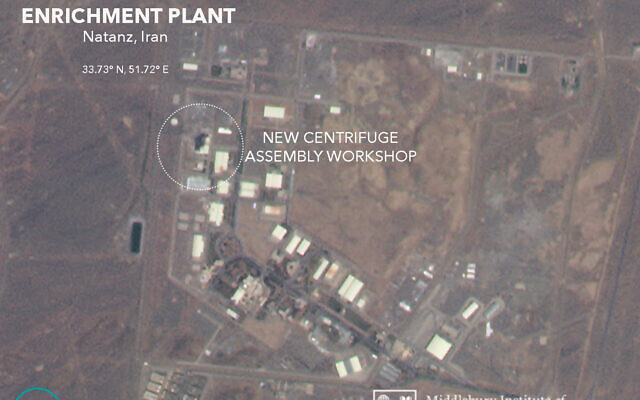
This Friday, July 3, 2020 satellite image from Planet Labs Inc. that has been annotated by experts at the James Martin Center for Nonproliferation Studies at Middlebury Institute of International Studies shows a damaged building after a fire and explosion at Iran’s Natanz nuclear site. (Planet Labs Inc., James Martin Center for Nonproliferation Studies at Middlebury Institute of International Studies via AP)
Israel is reportedly bracing for a possible Iranian retaliation as officials in Tehran suggested on Friday that a mystery fire and explosion at a top-secret nuclear complex could have been caused by an Israeli cyberattack.
An Israeli TV report Friday night said the attack “destroyed” a laboratory where Iran was developing advanced centrifuges for faster uranium enrichment, and a Kuwaiti report quoted an unnamed source assessing that the strike set back the Iranian nuclear program by two months.
Three Iranian officials told the Reuters news agency they believed the incident at the Natanz enrichment facility early Thursday was the result of a cyberattack, and two of them said Israel could have been behind it but offered no evidence.
Asked about reports of the incident at a press conference Thursday evening, Israel’s Prime Minister Benjamin Netanyahu brushed aside the question: “I don’t address these issues,” he said.

Prime Minister Benjamin Netanyahu delivers a press statement from his office in Jerusalem, July 2, 2020. (Screen capture: YouTube)
But Amos Yadlin, the head of the Institute for National Security Studies, and a former head of IDF military intelligence, tweeted Friday that, “According to foreign sources, it appears that the prime minister focused this week on Iran rather than [his plan for West Bank] annexation. This is the policy I’ve been recommending in the last few weeks.”
Added Yadlin: “If Israel is accused by official sources then we need to be operationally prepared for the possibility of an Iranian reaction (through cyber, firing missiles from Syria or a terror attack overseas).”
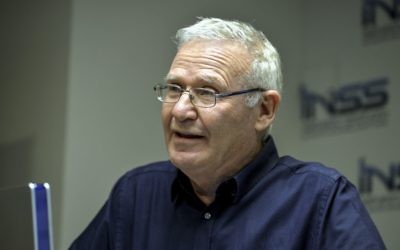
Amos Yadlin (Flash90)
Officially, Iran reported an “accident” occurred Thursday at the Natanz nuclear complex in central Iran, saying there were no casualties or radioactive pollution. But top generals also said Iran would respond if the incident turned out to be a cyberattack.
“If it is proven that our country has been attacked by cyberattacks, we will respond,” warned Gen. Gholam Reza Jalali, the head of Iran’s military unit in charge of combating sabotage, according to a report late Thursday by the Mizan news agency.
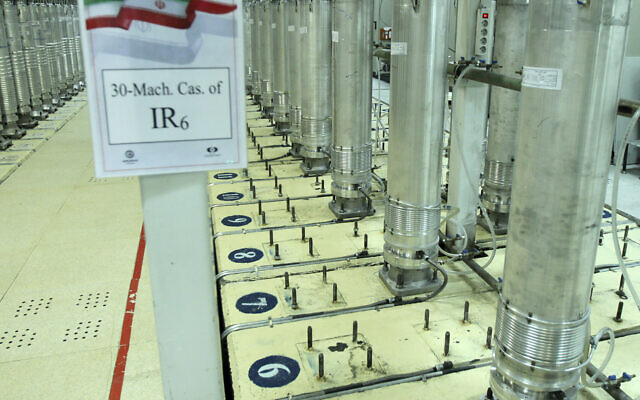
Centrifuge machines in the Natanz uranium enrichment facility in central Iran, November 5, 2019. (Atomic Energy Organization of Iran via AP, File)
Israel’s Channel 13 TV military analyst Alon Ben-David said Friday evening that the attack hit “the facility where Iran develops more advanced centrifuges — what are meant to be the next stage of the nuclear program, to produce enriched uranium at a far faster rate. That facility yesterday took a substantial hit; the explosion destroyed this lab.
“Those were centrifuges that were supposed to be installed underground at the Natanz facility; they were intended to replace the old centrifuges and produce a lot more enriched uranium, a lot more quickly,” he added. “They suffered a blow. It has to be assumed that at some stage, they will want to retaliate.”
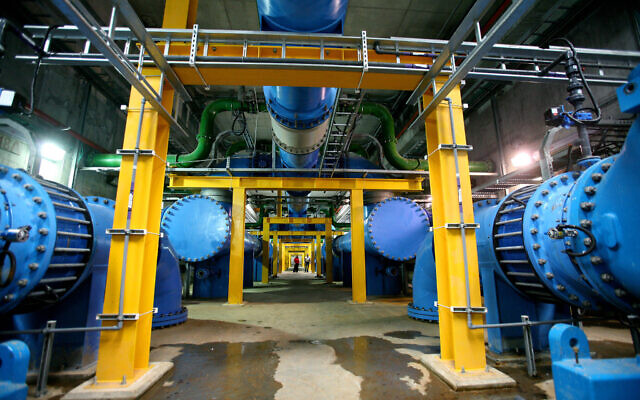
View of the Eshkol Water Filtration Plant in northern Israel, on April 17, 2007. (Moshe Shai/FLASH90)
Ben-David said Israel was “bracing” for an Iranian response, likely via a cyberattack. In an April cyberattack attributed by western intelligence officials to Iran, an attempt was made to increase chlorine levels in water flowing to residential Israeli areas.
Hours after the Natanz fire and reported explosion on Thursday, Iran’s state news agency IRNA published an editorial warning that “if there are signs of hostile countries crossing Iran’s red lines in any way, especially the Zionist regime (Israel) and the United States, Iran’s strategy to confront the new situation must be fundamentally reconsidered.”
IRNA also reported that unnamed Israeli social media accounts had claimed the Jewish state was responsible for the “sabotage attempts.”
It stressed that Iran had tried “to prevent escalations and unpredictable situations while defending its position and national interests.”
Natanz, located some 250 kilometers (155 miles) south of Tehran, includes underground facilities buried under some 7.6 meters (25 feet) of concrete, which offers protection from airstrikes.
There was “no nuclear material (at the damaged warehouse) and no potential of pollution,” the spokesman for Iran’s Atomic Energy Organisation Behrouz Kamalvandi told state television.
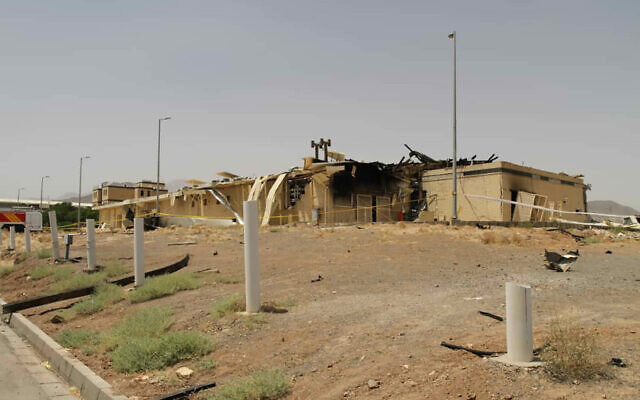
This photo released on July 2, 2020, by the Atomic Energy Organization of Iran, shows a building after it was damaged by a fire, at the Natanz uranium enrichment facility some 200 miles (322 kilometers) south of the capital Tehran, Iran. (Atomic Energy Organization of Iran via AP)
Kamalvandi said no radioactive material or personnel were present at the warehouse within the Natanz site in central Iran, one of the country’s main uranium enrichment plants.
He noted that the cause was being investigated, and said it had caused “some structural damage” without specifying the nature of the accident.
The Iranian Atomic Energy Organization released a photo purportedly from the site, showing a one-story building with a damaged roof, walls apparently blackened by fire and doors hanging off their hinges as if blown out from the inside.
The next stage of the nuclear program
Two US-based analysts who spoke to The Associated Press on Thursday, relying on released pictures and satellite images, identified the affected building as Natanz’s new Iran Centrifuge Assembly Center.
On Friday, a Kuwaiti newspaper reported Israel was responsible for two recent blasts at Iranian facilities — the one at Natanz, and another at a missile production site days earlier.
The Al-Jareeda daily cited an unnamed senior source as saying that an Israeli cyberattack caused a fire and explosion at Natanz.
According to the source, this was expected to set back Iran’s nuclear enrichment program by approximately two months.
The newspaper also reported that last Friday Israeli F-35 stealth fighter jets bombed a site located in the area of Parchin, which is believed to house a missile production complex — an area of particular concern for the Jewish state, in light of the large number and increasing sophistication of missiles and rockets in the arsenals of Iranian proxies, notably Lebanon’s Hezbollah.
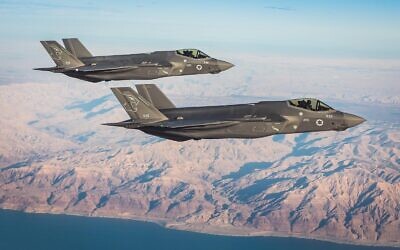
Fighter jets from the IAF’s second F-35 squadron, the Lions of the South, fly over southern Israel (IDF spokesperson)
Neither of these claims were confirmed by Israeli officials, who have been mum on the reports.
The reported Israeli strikes followed an alleged Iranian attempt to hack into Israel’s water infrastructure in April, an effort that was thwarted by Israeli cyber defenses, but if successful could have introduced dangerous levels of chlorine into the Israeli water supply and otherwise seriously interrupted the flow of water throughout the country.
Ultimately, the alleged Iranian cyberattack caused minimal issues, according to Israeli officials.
The alleged Israeli attacks also came amid an ongoing campaign of so-called maximum pressure by the United States in the form of crushing sanctions on Iran and Iranian officials.
The BBC’s Persian service said it received an email from a group identifying itself as the “Cheetahs of the Homeland” claiming responsibility for the attack. The email was received prior to the announcement of the Natanz fire.
The group, which claimed to be dissident members of Iran’s security forces, had never been heard of before by Iran experts and the claim could not be immediately authenticated by The Associated Press.
The site of the fire corresponds to a newly opened centrifuge production facility, said Fabian Hinz, a researcher at the James Martin Center for Nonproliferation Studies at the Middlebury Institute of International Studies in Monterey, California. He said he relied on satellite images and a state TV program on the facility to locate the building, which sits in Natanz’s northwest corner.
David Albright of the Institute for Science and International Security similarly said the fire struck the production facility. His institute previously wrote a report on the new plant, identifying it from satellite pictures while it was under construction and later built.

A fire has burned a building above Iran’s underground Natanz nuclear enrichment facility, though officials say it did not affect its centrifuge operation or cause any release of radiation. (AP graphic)
Iranian nuclear officials did not respond to a request for comment about the analysts’ comments.
Last Friday, a large blast was felt in Tehran, apparently caused by an explosion at the Parchin military complex, which defense analysts believe hold an underground tunnel system and missile production facilities.
According to the al-Jareeda report on Friday, that explosion was caused by missiles dropped by a number of Israeli F-35 stealth fighter jets. The newspaper reported that the aircraft took off from southern Israel and carried out the bombing run without the need to refuel.
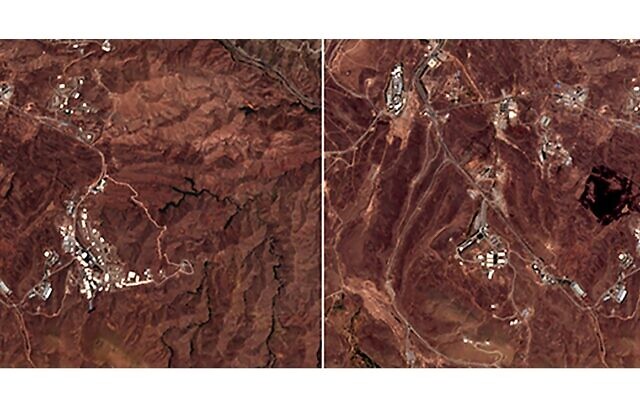
This Friday, June 26, 2020, photo combo from the European Commission’s Sentinel-2 satellite shows the site of an explosion, before, left, and after, right, that rattled Iran’s capital. Analysts say the blast came from an area in Tehran’s eastern mountains that hides a underground tunnel system and missile production sites. The explosion appears to have charred hundreds of meters of scrubland. (European Commission via AP)
The Fars news agency, which is close to the country’s ultra-conservatives, initially reported that Parchin blast was caused by “an industrial gas tank explosion” near a facility belonging to the defense ministry. It cited an “informed source” and said the site of the incident was not related to the military.
However, this was largely disregarded by defense analysts as satellite photographs of the Parchin military complex emerged showing large amounts of damage at the site.
Later, Iranian Defense Ministry spokesman Davood Abdi blamed the blast on a leaking gas that he did not identify and said no one was killed in the explosion.
Satellite photos of the area, some 20 kilometers (12.5 miles) east of downtown Tehran, showed hundreds of meters (yards) of charred scrubland not seen in images of the area taken in the weeks ahead of the incident. The building near the char marks resembled the facility seen in the state TV footage.
The gas storage area sits near what analysts describe as Iran’s Khojir missile facility. The explosion appears to have struck a facility for the Shahid Bakeri Industrial Group, which makes solid-propellant rockets, said Fabian Hinz.
The Washington-based Center for Strategic and International Studies identified Khojir as the “site of numerous tunnels, some suspected of use for arms assembly.” Large industrial buildings at the site visible from satellite photographs also suggest missile assembly being conducted there.
Iranian officials themselves also identified the site as being home to a military base where the International Atomic Energy Agency previously said it suspects Iran conducted tests of explosive triggers that could be used in nuclear weapons. Iran long has denied seeking nuclear weapons, though the IAEA previously said Iran had done work in “support of a possible military dimension to its nuclear program” that largely halted in late 2003.
Western concerns over the Iranian atomic program led to sanctions and eventually to Tehran’s 2015 nuclear deal with world powers. The US under President Donald Trump unilaterally withdrew from the accord in May 2018, leading to a series of escalating attacks between Iran and the US, and to Tehran abandoning the deal’s production limits.
Judah Ari Gross contributed to this report
[Disclaimer]









